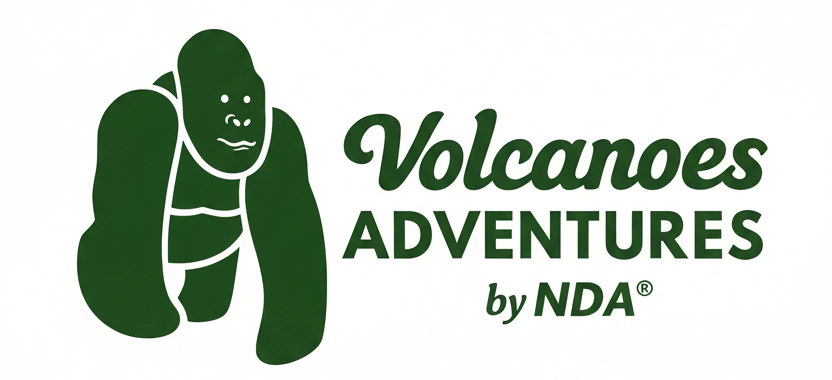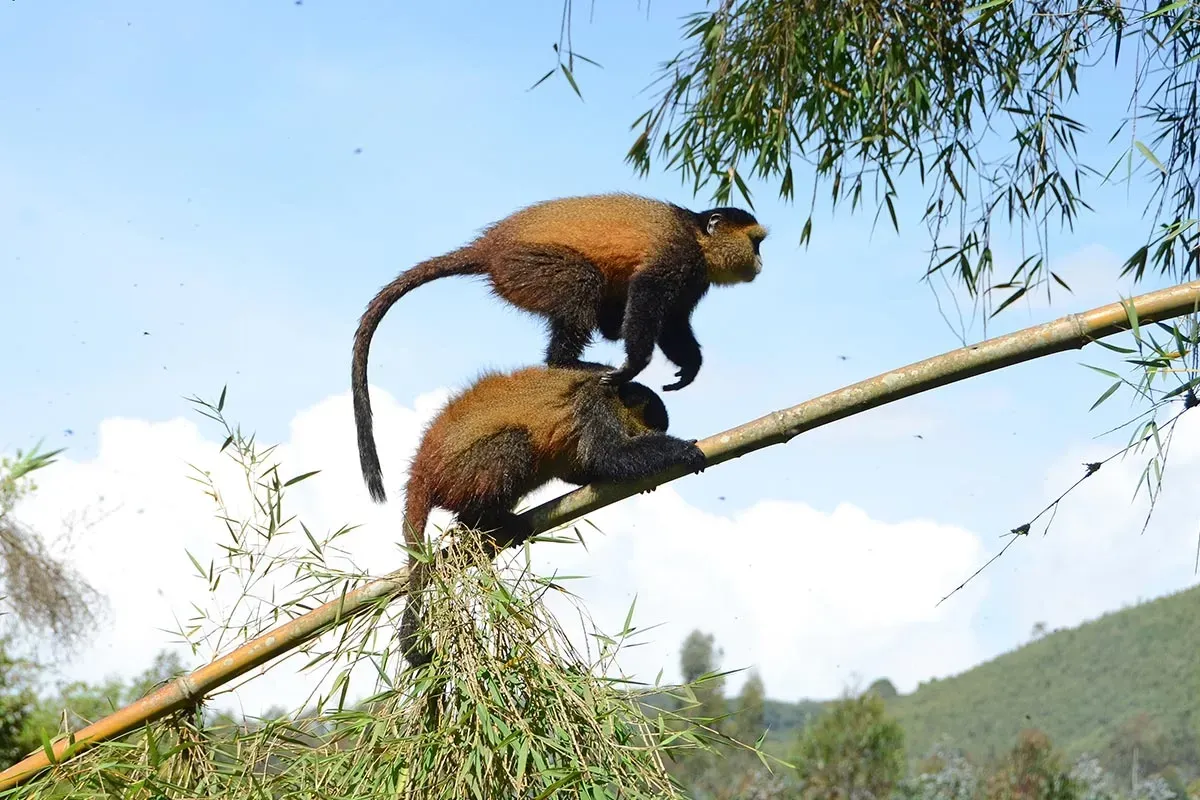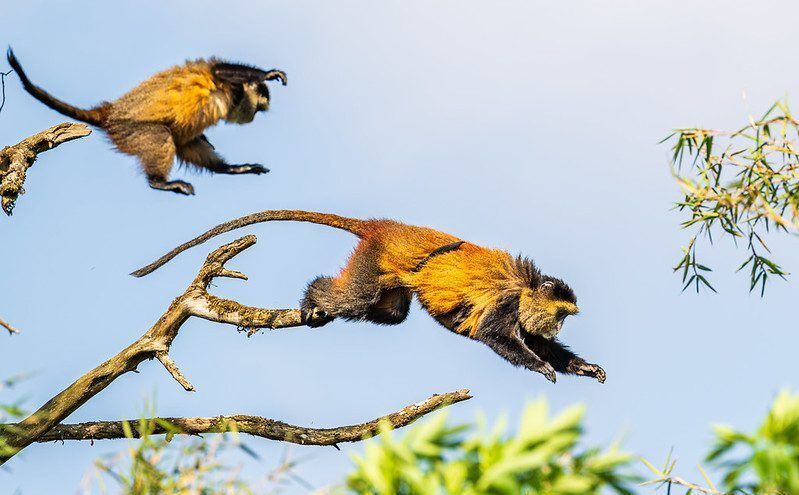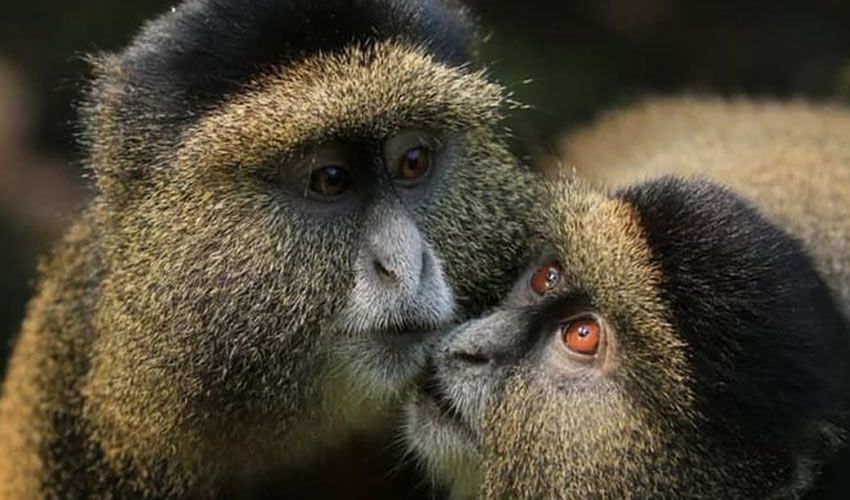Golden Monkey Tracking Rwanda | Volcanoes National Park
Golden monkey tracking in Volcanoes National Park offers an enchanting encounter with one of Africa's most endangered and playful primates. Found only in the Virunga Mountains and Gishwati-Mukura National Park in Rwanda, golden monkeys captivate visitors with their striking golden-orange fur, acrobatic antics, and energetic social interactions in bamboo forests.
Golden monkey tracking at Volcanoes National Park provides an accessible, affordable alternative or perfect complement to gorilla trekking. With permits at just $100 (compared to $1,500 for gorilla trekking), golden monkey tracking offers exceptional wildlife value in one of Rwanda's most beautiful national parks.
Golden Monkey Tracking at a Glance
- Location: Volcanoes National Park, Northern Rwanda
- Duration: Half-day (4-5 hours including trek and observation)
- Permit Cost: $100 USD per person
- Difficulty: Moderate
- Best Time: Year-round; dry season preferred (June-September)
- Group Size: Maximum 8 visitors per group
- Observation Time: Up to 1 hour with golden monkeys
- Minimum Age: 15 years
- Population: Approximately 80-100 golden monkeys in Volcanoes National Park
- Success Rate: 95%+ (golden monkeys are highly mobile but usually located)
What Are Golden Monkeys?
Scientific Name: Cercopithecus kandti (Golden Monkey) or Cercopithecus mitis kandti (subspecies classification)
Conservation Status: Endangered
Unique Characteristics: Golden monkeys are Old World monkeys distinguished by their striking golden-orange patches on their backs and flanks, contrasting with black limbs, crown, and tail. These beautiful primates are endemic to the Albertine Rift montane forests and found only in the Virunga volcanic region spanning Rwanda, Uganda, and the Democratic Republic of Congo.
Physical Features:
- Adults weigh 10-14 kg (22-31 pounds)
- Body length: 48-67 cm (19-26 inches)
- Long tail (65-90 cm) used for balance during acrobatic displays
- Golden-orange body fur with black limbs
- White cheek patches
- Expressive faces and alert eyes
Habitat: Golden monkeys live exclusively in bamboo forests at 2,200-3,600 meters elevation in Volcanoes National Park. Their entire ecology revolves around bamboo, which comprises 85-90% of their diet. This habitat specialization makes them vulnerable to bamboo forest loss.
Diet:
- Bamboo shoots, leaves, and stems (primary food)
- Bamboo fruit during fruiting season
- Supplemented with flowers, fruits, leaves from other plants
- Occasionally insects and small invertebrates
Social Structure: Golden monkeys live in large, dynamic troops of 30-100 individuals. Unlike mountain gorillas with dominant silverbacks, golden monkey troops have multiple adult males with complex social hierarchies. Groups are exceptionally active, constantly moving, feeding, playing, and communicating with varied vocalizations.
Behavior: Known for their playful, acrobatic nature. Golden monkeys leap between bamboo stems, hang upside down while feeding, chase each other through the canopy, and engage in social grooming. Their energy level is remarkable – far more active than gorillas – making tracking an exciting, fast-paced experience.
Why Track Golden Monkeys in Volcanoes National Park?
Unique Wildlife Experience
Golden monkey tracking offers a completely different primate experience from gorilla trekking. While gorillas are contemplative and gentle giants, golden monkeys are energetic acrobats putting on a continuous show of leaps, chases, and playful interactions. Their constant motion and social dynamics create engaging, entertaining observations.
Endangered Species Conservation
Golden monkeys are classified as endangered with declining populations due to habitat loss. By participating in golden monkey tracking at Volcanoes National Park, you directly support conservation efforts protecting bamboo forests and monitoring golden monkey populations. Your permit fee funds anti-poaching patrols, habitat protection, and research.
Affordable Rwanda Wildlife Experience
At $100 per permit, golden monkey tracking is significantly more accessible than gorilla trekking ($1,500). This makes Volcanoes National Park experiences available to more visitors while still delivering extraordinary wildlife encounters and supporting conservation.
Perfect Complement to Gorilla Trekking
Most visitors combine golden monkey tracking with gorilla trekking for a comprehensive primate experience. After the profound, emotional encounter with mountain gorillas, golden monkey tracking offers lighter, energetic entertainment showcasing a different side of Volcanoes National Park's primate diversity.
Beautiful Bamboo Forest Setting
The bamboo forests where golden monkeys live create a unique, atmospheric environment. Sunlight filtering through dense bamboo creates magical lighting, while the sound of bamboo stems creaking in the wind adds to the enchantment. The habitat itself is part of the experience.
Accessible for More Fitness Levels
Golden monkey tracking generally involves less elevation gain and shorter trekking distances than gorilla trekking. While still requiring moderate fitness, it's often more accessible for visitors concerned about the physical demands of gorilla trekking's steep, muddy trails.
Excellent Photography Opportunities
Golden monkeys' constant activity and striking coloration create fantastic photography opportunities. Unlike gorilla trekking where movements must be slow and quiet, golden monkey tracking allows slightly more flexibility for positioning and capturing dynamic action shots of these acrobatic primates.
What to Expect: Golden Monkey Tracking Experience
Pre-Trek Briefing (7:00 AM)
Your golden monkey tracking experience begins at Volcanoes National Park headquarters in Kinigi. Arrive by 7:00 AM for check-in and permit verification.
Briefing includes:
- Golden monkey behavior and ecology
- Tracking procedures and safety guidelines
- Photography tips for active subjects
- Environmental protection protocols
- Group assignments (maximum 8 visitors per group)
Porter Services: Porters are available ($15-20) to carry your daypack. While golden monkey tracking typically involves less elevation gain than gorilla trekking, porters still provide valuable assistance navigating muddy bamboo forests.
The Trek to Bamboo Forests (30 minutes - 1.5 hours)
After the briefing, drive or walk to the trailhead where golden monkeys were last spotted.
Trek characteristics:
- Usually shorter than gorilla trekking (30-90 minutes)
- Through agricultural land before entering bamboo forest
- Elevation: 2,400-3,200 meters
- Terrain: Moderate with some steep, muddy sections
- Dense bamboo makes for atmospheric hiking
- Listen for golden monkey vocalizations as you approach
Tracking Process: Trackers locate golden monkey troops early each morning and radio the group's location to guides. Unlike gorillas that move slowly, golden monkeys range widely through bamboo forests, covering significant distances as they feed. Guides lead you to the troop's general area, then track movement through bamboo forests.
The Encounter: One Hour with Golden Monkeys
Once trackers locate the golden monkey troop, your guide positions your group for optimal viewing while maintaining the required 4-meter distance (closer than gorilla trekking's 7-meter rule).
What you'll observe:
Feeding Behavior: Watch golden monkeys expertly strip bamboo shoots, bite bamboo stems to extract pulp, and hang upside-down while feeding. Their dexterity and acrobatic feeding positions are mesmerizing. Feeding occupies most of their time, but they do it with such energy and grace that it never feels boring.
Social Interactions: Golden monkey troops are highly social with constant interaction. You'll see juveniles playing, adults grooming each other, mothers nursing infants, and males displaying to establish hierarchy. The group dynamics are fascinating and provide insights into complex primate social structures.
Acrobatic Displays: Golden monkeys are the acrobats of the primate world. Watch them leap 3-4 meters between bamboo stems, swing through the canopy with effortless grace, chase each other at high speeds, and perform impressive aerial maneuvers. Their agility is extraordinary.
Vocalizations: Golden monkeys communicate with varied calls including chirps, whistles, chatters, and alarm calls. Learning to recognize different vocalizations adds depth to your understanding of troop communication and helps anticipate behavior.
Photography: Golden monkeys move constantly, presenting both challenges and opportunities for photography. Their striking colors photograph beautifully against green bamboo. The challenge is capturing sharp images of fast-moving subjects in forest light. Faster shutter speeds are essential.
Group Dynamics: With 30-100 individuals, golden monkey troops offer constant activity in multiple directions. While you focus on one interaction, another fascinating behavior unfolds nearby. The abundance of activity ensures every moment is engaging.
Proximity: Golden monkeys are habituated to human presence and often approach quite close (respecting 4-meter minimum distance). Their curiosity sometimes brings them within a few meters, creating intimate encounters and excellent photo opportunities.
After the Encounter
Following your hour with golden monkeys, trek back to the trailhead (30-60 minutes). The return journey is typically easier as it's mostly downhill.
At park headquarters:
- Return for debriefing
- Receive your golden monkey tracking certificate
- Optional: Purchase crafts from local artisans
- Most tracking experiences conclude by noon
Rest of Day: Since golden monkey tracking is a half-day activity (typically 8 AM - 12 PM), you have afternoons free for additional activities, relaxation, or travel.
Golden Monkey Tracking Difficulty & Fitness Requirements
Golden monkey tracking is rated moderate – generally less demanding than gorilla trekking but still requiring reasonable fitness.
Physical Requirements:
- Moderate cardiovascular fitness
- Ability to hike 1-3 hours on uneven terrain
- Some steep sections through bamboo forest
- Balance for navigating muddy, root-covered trails
- No technical climbing or extreme challenges
Why It's Easier Than Gorilla Trekking:
- Generally shorter trekking distances
- Less total elevation gain
- Flatter terrain (gorillas often on steep slopes)
- Predictable locations (bamboo zones)
- Faster pace permitted (golden monkeys are active)
Challenges:
- Muddy trails (bamboo forest is often wet)
- Dense vegetation (bamboo can be claustrophobic)
- Fast-moving subjects (requires alertness)
- Altitude (2,400-3,200m can cause breathlessness)
Who Can Do It: Golden monkey tracking is suitable for most people in reasonable health. Families with teenagers (15+), older visitors, and those concerned about gorilla trekking's difficulty often find golden monkey tracking a perfect alternative.
What to Bring for Golden Monkey Tracking
Essential Gear
Footwear:
- Waterproof hiking boots with ankle support
- Gaiters (recommended for mud and water)
- Good traction for slippery bamboo forest floors
Clothing:
- Waterproof rain jacket (rain possible any time)
- Waterproof or quick-dry pants
- Long-sleeve shirt (bamboo can scratch)
- Light layers (mornings cool, afternoons warmer)
- Gardening gloves (for pushing through bamboo)
- Hat with brim
Camera Equipment:
- Camera with good autofocus (golden monkeys move fast)
- Fast lens (f/2.8 or faster preferred for forest light)
- Telephoto lens (70-200mm or 100-400mm ideal)
- High ISO capability (you'll shoot ISO 1600-6400)
- Multiple memory cards and batteries
- Weatherproof camera bag or rain cover
Other Essentials:
- 1-2 liters water (less than gorilla trekking)
- High-energy snacks
- Sunscreen and lip balm
- Small first aid kit
- Insect repellent
- Hand sanitizer
- Toilet paper
Optional but Helpful:
- Walking poles (for muddy sections)
- Binoculars (for distant monkeys)
- Notebook for observations
- Porter service ($15-20)
Best Time for Golden Monkey Tracking
Golden monkey tracking is available year-round in Volcanoes National Park, but weather affects trail conditions and monkey behavior.
Dry Season (June - September, December - February)
Best overall conditions:
Advantages:
- Drier trails (less mud in bamboo forest)
- Clearer skies (better photography lighting)
- Golden monkeys more visible (less dense vegetation)
- Easier hiking conditions
- More predictable weather
Considerations:
- Peak tourist season (more visitors)
- Book permits 1-2 months in advance
- Higher accommodation rates
- More trekking groups
Best for: Photographers, first-time visitors, those combining with gorilla trekking in dry season
Wet Season (March - May, October - November)
More challenging but rewarding:
Advantages:
- Lush, vibrant bamboo forests
- Fewer visitors (more intimate experience)
- Lower accommodation rates
- Dramatic photography with mist
- Golden monkeys very active (abundant bamboo shoots)
Challenges:
- Muddy trails (expect to get dirty)
- Rain likely (bring quality rain gear)
- Reduced visibility (dense vegetation)
- More physically demanding
Best for: Experienced hikers, budget travelers, those seeking solitude
Bamboo Shooting Season (February - April)
Golden monkeys are particularly active during bamboo shooting season when new, tender bamboo shoots emerge. This is their favorite food, creating excellent viewing opportunities as troops congregate in areas with abundant shoots.
Golden Monkey Tracking Permits & Pricing
Permit Cost: $100 USD per person
What's Included:
- Park entrance fee
- One hour with golden monkey troop
- Expert park ranger guide
- Tracking and locating services
- Golden monkey tracking certificate
What's NOT Included:
- Transport to/from Volcanoes National Park
- Accommodation
- Meals
- Porter services ($15-20 optional)
- Tips for guides and porters
- Personal gear
How to Book Permits
Timeline: Book 2-4 weeks in advance during peak season (June-September), or 1-2 weeks for off-season. Golden monkey permits are more readily available than gorilla permits.
Booking Process:
- Contact tour operator or Rwanda Development Board
- Confirm preferred date
- Provide passport information
- Pay permit fee
- Receive confirmation
Cancellation Policy:
- 7+ days notice: Full refund minus administrative fee
- 3-6 days: 50% refund
- Less than 3 days: No refund
- Weather cancellations: Reschedule or refund
Combining Golden Monkey Tracking with Other Activities
Perfect Multi-Day Itineraries
2-Day Volcanoes Park Experience
- Day 1: Gorilla trekking (early morning)
- Day 2: Golden monkey tracking (morning) + cultural village (afternoon)
- Best for: Visitors wanting both primate experiences
3-Day Primate & Volcano Adventure
- Day 1: Gorilla trekking
- Day 2: Golden monkey tracking + afternoon relaxation
- Day 3: Mount Bisoke crater lake hike
- Best for: Active travelers combining wildlife and hiking
1-Day Double Tracking
- Morning: Golden monkey tracking
- Afternoon: Dian Fossey tomb hike or cultural experience
- Best for: Single-day visitors or gorilla trek rest day
5-Day Complete Volcanoes Experience
- Day 1: Arrive, park orientation
- Day 2: Gorilla trekking
- Day 3: Golden monkey tracking + cultural village
- Day 4: Volcano hiking (Mount Bisoke or Karisimbi)
- Day 5: Dian Fossey tomb or departure
- Best for: Comprehensive Rwanda adventure
Why Combine Golden Monkeys with Gorilla Trekking?
Contrasting Experiences: Gorilla trekking is profound, emotional, and contemplative. Golden monkey tracking is energetic, playful, and entertaining. Together, they showcase the remarkable diversity of Volcanoes National Park's primates.
Cost-Effective Add-On: At $100, golden monkey tracking adds significant value to your Rwanda visit without the expense of a second gorilla permit ($1,500).
Half-Day Activity: Golden monkey tracking concludes by noon, leaving afternoons free for other activities, rest, or travel – perfect scheduling flexibility.
Photography Portfolio: Adding golden monkeys provides contrasting images – from the power and gentleness of gorillas to the grace and energy of golden monkeys.
Golden Monkeys vs Gorilla Trekking: What's the Difference?
Experience Comparison
| Aspect | Golden Monkey Tracking | Gorilla Trekking |
|---|---|---|
| Permit Cost | $100 | $1,500 ($1,050 low season) |
| Duration | 4-5 hours (half-day) | 4-8+ hours (full day) |
| Difficulty | Moderate | Moderate to Strenuous |
| Animals | 30-100 golden monkeys | 10-30 gorillas (one family) |
| Behavior | Active, acrobatic, playful | Calm, gentle, contemplative |
| Distance Rule | 4 meters | 7 meters |
| Photography | Action shots, movement | Portraits, family interactions |
| Emotional Impact | Entertaining, joyful | Profound, moving, emotional |
| Habitat | Bamboo forest | Various forest zones |
| Success Rate | 95%+ | 98%+ |
| Availability | Good (fewer visitors) | Limited (high demand) |
| Observation Time | Up to 1 hour | 1 hour |
Which Should You Choose?
Choose Golden Monkey Tracking if:
- Budget is a primary concern ($100 vs $1,500)
- You have limited time (half-day vs full-day)
- You prefer active, energetic wildlife
- You're concerned about trekking difficulty
- You've already done gorilla trekking
- You want excellent photography opportunities
Choose Gorilla Trekking if:
- You're seeking a once-in-a-lifetime experience
- Budget allows for premium encounters
- You want profound, emotional wildlife encounters
- You're comfortable with strenuous hiking
Choose BOTH if:
- You want complete Volcanoes Park primate experience
- You have 2+ days in the area
- You appreciate different wildlife interactions
- You want to maximize Rwanda's primate diversity
Insider Tip: Most visitors who do both agree that golden monkey tracking shouldn't be missed. While gorillas are the headline attraction, golden monkeys often exceed expectations and provide surprisingly memorable experiences.
Golden Monkey Conservation
Conservation Status & Threats
Current Status: Golden monkeys are listed as Endangered by the IUCN Red List. The total population across their entire range (Rwanda, Uganda, DRC) is estimated at 3,000-4,000 individuals, with approximately 80-100 in Volcanoes National Park.
Primary Threats:
- Habitat Loss: Bamboo forest clearing for agriculture and settlement
- Bamboo Forest Degradation: Over-harvesting bamboo for crafts and construction
- Human-Wildlife Conflict: Competition for bamboo resources
- Disease Transmission: Risk from human contact (though less than gorillas)
- Climate Change: Affecting bamboo growth patterns and distribution
- Small Population Size: Genetic vulnerability and disease susceptibility
Conservation Efforts in Volcanoes National Park
Habitat Protection: Volcanoes National Park protects critical bamboo forest habitat. Park boundaries are strictly enforced, preventing encroachment and ensuring golden monkeys have secure habitat.
Population Monitoring: Rangers and researchers monitor golden monkey troops daily, tracking population dynamics, health, births, and behavior. This data informs conservation strategies.
Community Benefits: Golden monkey tracking permits generate revenue shared with local communities, creating economic incentives for conservation rather than forest clearing.
Bamboo Forest Management: Park management balances bamboo harvesting for local use with conservation needs, ensuring sustainable bamboo availability for both golden monkeys and people.
Research Programs: Ongoing research studies golden monkey ecology, diet, behavior, and habitat requirements, providing scientific basis for conservation decisions.
Habituation Programs: Carefully habituating golden monkey troops for tourism creates conservation value while minimizing stress on animals. Only select troops are habituated, leaving others undisturbed.
How Your Visit Helps
Direct Conservation Funding: Your $100 permit directly funds:
- Anti-poaching patrols protecting golden monkeys
- Habitat monitoring and protection
- Research programs
- Veterinary care for sick or injured monkeys
- Community conservation programs
Economic Value: Tourism demonstrates that living golden monkeys generate more economic value than cleared bamboo forests, incentivizing protection over habitat conversion.
Education & Awareness: Visitors become golden monkey ambassadors, spreading awareness about this endangered species and its conservation needs.
Community Support: Revenue sharing with local communities (10% of permit fees) directly benefits people living near the park, creating local support for conservation.
Safety & Regulations
Golden Monkey Tracking Rules
Mandatory Requirements:
- Maintain 4-meter distance (closer than gorillas' 7 meters)
- Golden monkeys may approach closer (that's okay)
- You must maintain minimum distance
- Maximum 1 hour observationStrictly enforced to minimize stress
- Ensures multiple groups can visit
- Maximum 8 visitors per groupReduces impact on golden monkeys
- Ensures quality experience
- No eating or drinking near golden monkeysPrevents disease transmission
- Avoids attracting monkeys to human food
- No flash photographyDisturbs golden monkeys
- Affects their vision
- Keep voices lowReduces stress on animals
- Enhances experience for all visitors
- Do not trek if sickProtects golden monkeys from disease
- Reschedule if unwell (bring medical documentation)
- Turn away if you cough or sneezeCover mouth and face away
- Prevents disease transmission
- No litteringPack out all trash
- Protect habitat
- Follow all guide instructionsGuides know golden monkey behavior
- Immediate obedience ensures safety
Health & Safety
Minimum Age: 15 years old (strictly enforced, ID required)
Fitness Requirements: Moderate fitness sufficient. If you can walk 2-3 hours on uneven terrain, you can track golden monkeys.
Altitude Considerations: Tracking occurs at 2,400-3,200m elevation. Mild altitude effects possible (headache, breathlessness). Ascend slowly and stay hydrated.
Disease Prevention: Golden monkeys are susceptible to human diseases, though less vulnerable than gorillas. If you're sick, you must reschedule.
Wildlife Safety: Golden monkeys are not dangerous. Unlike gorillas, they won't charge or display aggression toward humans. However, maintain respectful distance and follow guide instructions.
Trail Safety:
- Muddy, slippery trails require careful footing
- Walking poles help with balance
- Porter assistance available
- Stay with your group
Practical Information
Getting There
From Kigali:
- Distance: 116 km (2 hours drive)
- Well-paved road through scenic countryside
- Most tours include transport
Park Headquarters: Volcanoes National Park headquarters in Kinigi is the meeting point for all golden monkey tracking experiences.
Accommodation
Near Volcanoes National Park:
Luxury ($400-1,500/night):
- Bisate Lodge (eco-luxury)
- Singita Kwitonda Lodge
- One&Only Gorilla's Nest
- Virunga Lodge
Mid-Range ($150-400/night):
- Mountain Gorilla View Lodge
- Sabyinyo Silverback Lodge
- Le Bambou Gorilla Lodge
- Five Volcanoes Boutique Hotel
Budget ($50-150/night):
- Kinigi Guesthouse
- Garden Place Hotel
- La Palme Hotel
- Various Musanze guesthouses
What to Expect Weather-Wise
Temperature:
- Morning: 10-15°C (50-59°F)
- Midday: 15-20°C (59-68°F)
- Bamboo forest stays cool even on warm days
Rainfall:
- Possible year-round
- Heavier March-May and October-November
- Brief afternoon showers common
- Always bring rain gear
Altitude: 2,400-3,200m elevation. Cooler than lowland areas. Dress in layers.
Tipping Guidelines
Recommended Tips:
- Park ranger guide: $10-15
- Porters: $10-15
- Tips in USD preferred (clean, recent bills)
Frequently Asked Questions
Q: Is golden monkey tracking worth it? A: Absolutely! While overshadowed by gorilla trekking, golden monkey tracking provides exceptional wildlife encounters at a fraction of the cost. Most visitors are pleasantly surprised by how entertaining and engaging golden monkeys are.
Q: Can children do golden monkey tracking? A: Minimum age is 15 years (same as gorilla trekking). No exceptions.
Q: How close can you get to golden monkeys? A: Minimum distance is 4 meters (13 feet), but habituated golden monkeys often approach closer out of curiosity. You must maintain the 4-meter rule; they can break it.
Q: Are golden monkeys dangerous? A: No. Golden monkeys are not aggressive toward humans. They're curious, playful, and tolerant of observers after habituation.
Q: Can you do golden monkey tracking and gorilla trekking on the same day? A: Technically possible (golden monkeys in morning, gorillas in afternoon) but not recommended. Each deserves a full experience without rushing. Most do them on consecutive days.
Q: What's the success rate of seeing golden monkeys? A: Approximately 95%+. Trackers locate troops each morning. Golden monkeys move more than gorillas, but sightings are nearly guaranteed.
Q: How many golden monkeys will I see? A: Troops range from 30-100 individuals. You'll see the entire troop, including adults, juveniles, and infants.
Q: Can you touch golden monkeys? A: No. Touching is strictly prohibited for disease prevention and animal welfare.
Q: Is golden monkey tracking easier than gorilla trekking? A: Generally yes. Shorter distances, less elevation gain, and flatter terrain make it more accessible.
Q: Do I need a porter for golden monkey tracking? A: Not essential (less demanding than gorilla trekking), but porters help with muddy sections and support local communities.
Q: Can I take photos of golden monkeys? A: Yes! Photography is encouraged (without flash). Golden monkeys' constant activity creates excellent photo opportunities.
Q: What if it rains during tracking? A: Tracking continues in rain (it's a rainforest!). Bring quality rain gear. Trails will be muddier, but experience remains excellent.
Q: Are there other places to see golden monkeys in Rwanda? A: Yes, Gishwati-Mukura National Park also offers golden monkey tracking, but Volcanoes National Park has better habituation, infrastructure, and combines with gorilla trekking.
Q: How long should I stay in Volcanoes National Park? A: Minimum 2 days (one for gorillas, one for golden monkeys). Ideal: 3-4 days to include volcano hiking or cultural experiences.
Book Your Golden Monkey Tracking Experience
Ready to encounter Rwanda's enchanting golden monkeys?
What's Included in Our Golden Monkey Packages
All packages include:
✓ Golden monkey tracking permit ($100)
✓ Park entrance fees
✓ Expert park ranger guide
✓ Transport from Kigali or local accommodation
✓ Pre-trek briefing
✓ Porter coordination (if requested)
✓ Tracking certificate
Package Options:
Golden Monkey Day Trip ($150-200 per person)
- Transport from Kigali
- Golden monkey tracking
- Park fees and permits
- Return to Kigali
2-Day Gorilla & Golden Monkey ($1,850-2,300)
- Day 1: Gorilla trekking
- Day 2: Golden monkey tracking
- 1 night accommodation
- All permits and transport
3-Day Primate Adventure ($2,100-2,800)
- Gorilla trekking
- Golden monkey tracking
- Cultural village or volcano hiking
- 2 nights accommodation
- All inclusive
Booking Timeline:
- Peak season: Book 1-2 months ahead
- Off-season: Book 2-4 weeks ahead
- Last-minute: Contact us for availability
Why Book With Us
✓ Expert local guides
✓ Enhanced cancellation policy option
✓ Flexible itineraries
✓ 24/7 in-country support
✓ Sustainable, responsible tourism
✓ Supporting conservation and communities
Start Planning Your Golden Monkey Adventure Today
Experience the acrobatic golden monkeys of Volcanoes National Park. Contact us to book your permit or create a custom Rwanda primate safari.

















